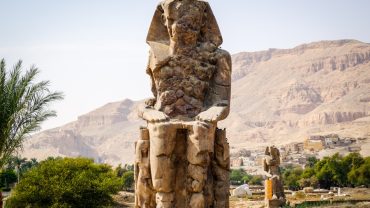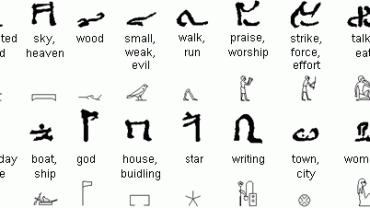The Pyramids of Giza
The Pyramids of Giza are one of the Seven Wonders of the World and one of the most iconic landmarks in Egypt. They were built as tombs for the pharaohs of the Fourth Dynasty, and they remain a source of wonder and fascination to people from all over the world.
The largest of the pyramids is the Great Pyramid of Khufu, which was built for the pharaoh Khufu. It is the largest man-made structure in the world, and it is estimated to have taken over 20 years to build. The pyramid is made of limestone blocks, and it is estimated to contain over 2 million blocks.
The other two pyramids at Giza are the Pyramid of Khafre and the Pyramid of Menkaure. They are smaller than the Great Pyramid, but they are still impressive structures. The Pyramid of Khafre is the second-largest pyramid in the world, and it is the tallest standing structure in Egypt. The Pyramid of Menkaure is the third-largest pyramid in the world.
The pyramids are not just impressive structures; they are also important archaeological sites. They have yielded a wealth of information about ancient Egyptian culture and technology. The pyramids were built using a variety of techniques, including ramps, levers, and pulleys. The Egyptians were also skilled engineers, and they were able to build the pyramids with great precision.
The pyramids are a testament to the ingenuity and engineering skills of the ancient Egyptians. They are also a reminder of the power and wealth of the Egyptian pharaohs. The pyramids are a UNESCO World Heritage Site, and they are one of the most popular tourist destinations in Egypt.
The Pyramids and Egyptian Religion
The pyramids were not just tombs; they were also important religious symbols. They were believed to represent the pharaoh’s journey to the afterlife. The pyramids were believed to be a way for the pharaoh to reach the sun god, Ra.
The pyramids were also important for the Egyptian economy. They required a large workforce to build, and they provided employment for thousands of people. The pyramids were also a source of revenue for the Egyptian government. The pyramids are a reminder of the rich and complex culture of ancient Egypt. They are a testament to the ingenuity and engineering skills of the ancient Egyptians, and they are a source of wonder and fascination for people from all over the world.
Pyramid Construction Techniques
The construction of pyramids was an incredible feat of engineering and architectural skill. The ancient Egyptians developed innovative techniques to build these towering structures that still amaze us today. The process involved careful planning, precise measurements, and the use of advanced tools.
One of the key techniques utilized by the ancient Egyptians was the use of ramps. These ramps allowed the workers to transport heavy blocks of stone to the desired height. The ramps were built using a combination of mud bricks and logs, creating a sturdy structure that could support the weight of the stones.
Another technique employed by the Egyptians was the use of lever systems. These levers provided a mechanical advantage, allowing the workers to lift and move heavy stones with relative ease. The levers were often made from wood and were strategically placed to distribute the weight evenly.
Additionally, the Egyptians used a method known as „quarrying“ to extract the stone needed for the construction of the pyramids. They would identify suitable quarries and then chisel away at the rock to create individual blocks. These blocks would then be transported to the building site using the aforementioned ramp and lever systems.
Pyramid Construction History
The construction of pyramids in ancient Egypt spans a long and fascinating history that provides insight into the beliefs and motivations of the ancient Egyptians. The earliest known pyramid dates back to the Third Dynasty, with King Djoser’s Step Pyramid being the first of its kind.
Over time, the design and construction techniques of the pyramids evolved. The Step Pyramid was followed by the True Pyramids, which featured smooth, sloping sides. The most famous of these is the Great Pyramid of Giza, built for Pharaoh Khufu.
The construction of pyramids continued throughout ancient Egyptian civilization, with each pharaoh aspiring to build a grander and more impressive structure than their predecessors. The pyramids served as tombs for the pharaohs, believed to be essential for their journey to the afterlife.
Despite the grandeur and magnificence of the pyramids, their construction was not without challenges. The massive size and weight of the stones required a tremendous amount of manpower and resources. However, the ancient Egyptians were able to overcome these obstacles, leaving behind a lasting legacy that continues to captivate people worldwide.
Cultural Significance of Pyramids
The pyramids held significant cultural and spiritual importance in ancient Egyptian society. They were more than just monumental structures; they were a reflection of the Egyptians‘ deep-rooted beliefs and their connection to the divine.
For the ancient Egyptians, the pyramids symbolized the pharaoh’s ascent to the heavens, where they would join the gods and achieve immortality. The shape of the pyramid, with its sloping sides leading to a point, represented the sacred mound that arose from the watery chaos at the beginning of creation.
Furthermore, the construction of pyramids involved the entire community, from farmers to skilled craftsmen. It was a collective effort that fostered a sense of unity and purpose among the ancient Egyptians. The pyramids served as a physical representation of the power and authority of the pharaoh, reinforcing the social hierarchy and the divine right to rule.
Moreover, the pyramids were not only places of burial but also served as temples and religious complexes. They were the focal point of religious rituals and offerings dedicated to the pharaoh and the gods. The hieroglyphs and intricate carvings inside the pyramids provided a glimpse into the religious beliefs and mythologies of ancient Egypt.
The cultural significance of the pyramids extended beyond their construction. These monumental structures became symbols of Egyptian civilization and continue to inspire awe and fascination to this day. They stand as a testament to the incredible achievements of the ancient Egyptians and their deep spiritual connection to the divine.
The Great Pyramid of Giza: A Monument to Immortality
Beyond majestic tomb, the Great Pyramid of Giza stands as a powerful symbol of ancient Egyptian beliefs. Not just a resting place for Pharaoh Khufu, its towering form echoes profound themes of creation, rebirth, and the pharaoh’s divine connection to the cosmos.
Here’s a glimpse into its significance:
Mirroring the Primeval Mound: Its shape reflects the Egyptians‘ creation myth, where life sprang from a primordial mound rising from the chaos. Each stone echoes the fertile earth, promising the pharaoh’s eternal renewal.
Solar Alignment and Rebirth: Aligned with the cardinal points and celestial bodies, the pyramid embodies the daily and annual cycles of the sun, representing the pharaoh’s rebirth alongside the sunrise.
Stairway to the Heavens: Passageways and chambers symbolize the journey the pharaoh’s soul takes through the underworld, culminating in ascension to the sun god’s realm.
Osiris and the Duat: The pyramid’s interior mirrors the Duat, the underworld where Osiris, the god of resurrection, resides. The pharaoh, identified with Osiris, seeks rejuvenation within these sacred spaces.
An Enduring Legacy: More than just a tomb, the Great Pyramid stands as a testament to the ingenuity and spiritual depth of ancient Egypt, inspiring awe and wonder for millennia.
The Great Pyramid: A Legacy Built in Stone and Time
Towering out of the desert sands, the Great Pyramid of Giza isn’t just a pile of stones. It’s a frozen poem, etched in limestone and granite, whispering tales of an ancient civilization’s dreams and beliefs. This magnificent monument isn’t simply a tomb; it’s a beacon of eternity, a testament to the pharaoh’s divinity, and a portal to the heavens.
More than a mausoleum, the Great Pyramid embodies a symphony of meaning
- Echoes of Creation: Its very shape – a colossal pyramid rising from the earth – mirrors the Egyptians‘ creation myth, where life first sprouted from a primeval mound. Each block whispers of rebirth, promising the pharaoh a new dawn beyond the veil of death.
- Aligned with the Cosmos: Precisely oriented to the cardinal points and celestial bodies, the pyramid dances with the sun, moon, and stars. It becomes a sundial of eternity, mirroring the daily and annual cycles of the cosmos, ensuring the pharaoh’s rebirth alongside the rising sun.
- A Stairway to the Heavens: Ascending passages and chambers map the pharaoh’s soul’s journey through the underworld, a perilous path ultimately leading to the celestial realm. They become testaments to the pharaoh’s divine lineage, granting him access to the realm of the gods.
- Osiris and the Duat: The pyramid’s interior echoes the Duat, the mysterious underworld where Osiris, the god of resurrection, dwells. Here, the pharaoh merges with Osiris, seeking rejuvenation and eternal life within these sacred chambers.
- A Whispering Echo: The Great Pyramid isn’t merely a relic of the past; it’s a living testament to the ingenuity and spiritual depth of ancient Egypt. Its whispers transcend time, inspiring awe and wonder even in the hearts of modern-day visitors.
The Great Pyramid is more than just stones stacked high; it’s a legacy in stone and time. It’s a testament to human ambition, a canvas painted with celestial dreams, and a portal to eternity.
This rephrased version retains the key themes of the previous one while incorporating some poetic elements and imagery to add depth and emotional resonance. It also emphasizes the enduring legacy of the Great Pyramid and its continued ability to inspire wonder and imagination.
Beyond Tomb: The Purpose and Symbolism of the Pyramids
While it’s true that the pyramids served as monumental tombs for the pharaohs, their purpose and symbolism extended far beyond simply housing the royal dead. They were, in essence, multifaceted testaments to ancient Egyptian beliefs and aspirations.
Here’s a closer look at the multifaceted purpose and symbolism behind the pyramids:
1. A Bridge to the Afterlife:
- Mirroring the Primeval Mound: The pyramid’s shape echoed the Egyptians‘ creation myth, where life emerged from a primordial mound rising from the chaos. Each stone represented a fragment of this life-giving earth, promising the pharaoh’s eternal renewal.
- Stairway to the Heavens: Passageways and chambers symbolized the pharaoh’s soul’s journey through the underworld, ultimately leading to ascension to the sun god’s realm. The pyramid became a physical pathway to the celestial beyond.
- Union with Osiris: The interior spaces often mirrored the Duat, the underworld where Osiris, the god of resurrection, resided. The pharaoh, identified with Osiris, sought rejuvenation and eternal life within these sacred chambers.
2. A Symbol of Power and Divinity:
- Monumental Presence: The sheer size and complexity of the pyramids served as a tangible display of the pharaoh’s power and authority. They were physical manifestations of his divine status, connecting him to the gods and solidifying his position as a living god on Earth.
- Alignment with the Cosmos: The precise orientation of the pyramids – aligned with the cardinal points and celestial bodies – reinforced the pharaoh’s connection to the divine order. They became earthly reflections of the heavens, further solidifying his role as a mediator between the gods and mankind.
- Enduring Legacy: The pyramids were intended to withstand the test of time, serving as permanent testaments to the pharaoh’s reign and ensuring his memory and divine image lived on for eternity.
3. A Tool for Religious Ritual and Practice:
- Offerings and Rituals: Temples and mortuary complexes surrounding the pyramids served as venues for elaborate funerary rituals and offerings. These practices ensured the pharaoh’s continued well-being in the afterlife and maintained his connection to the living world.
- Astral Alignments: Certain pyramids were designed to align with specific celestial events, such as solstices or equinoxes. These alignments played a role in astronomical observations and religious ceremonies, connecting the earthly events to the grand cycles of the cosmos.
- Cosmic Power: The very act of constructing such massive structures was seen as a sacred undertaking, channeling the collective energy of the people and tapping into the divine power of the universe.
Unveiling the Nile’s Splendor: A Glimpse into Ancient Egyptian Civilization
Emerging from the lifeblood of the Nile River, ancient Egypt flourished for millennia, leaving behind a legacy etched in pyramids, hieroglyphs, and captivating myths. Understanding the background of this civilization is key to unlocking the secrets whispered by their monuments, like the majestic pyramids.
Cradle of the Nile:
Geography: Bounded by deserts, the Nile became the fertile artery of Egypt, nurturing life and shaping its culture. Annual floods deposited rich silt, enabling agriculture and laying the foundation for prosperity.
Dynastic Rule: For over 3,000 years, Egypt was governed by dynasties of pharaohs, considered divine intermediaries between gods and mankind. Their centralized rule fostered stability and monumental projects like the pyramids.
Polytheistic Beliefs: Egyptians worshipped a vibrant pantheon of gods like Osiris (god of the underworld), Ra (sun god), and Isis (goddess of magic). These deities permeated every aspect of life, from daily rituals to grand temples.\
Life on the Nile:
Social Hierarchy: A rigid social order placed the pharaoh at the apex, followed by nobles, priests, farmers, artisans, and slaves. Each played a vital role in the smooth functioning of the society.
Agriculture and Trade: The fertile Nile Valley and skilled farmers thrived on crops like wheat, barley, and flax. Trade flourished along the Nile and with neighboring regions, enriching the kingdom.
Arts and Crafts: Egyptians excelled in intricate mummification techniques, breathtaking art and architecture, and sophisticated writing systems like hieroglyphs. Their artistic legacy continues to mesmerize us.
Echoes in Stone:
Pyramids as Tombs: These monumental structures housed the pharaohs‘ bodies, but their purpose extended far beyond. They were symbols of their divine status, pathways to the afterlife, and testaments to their earthly power.
Temples and Worship: Towering temples served as abodes for deities, adorned with hieroglyphs and vibrant murals. Priests performed elaborate rituals, ensuring cosmic balance and divine favor.
Mummies and the Afterlife: Egyptians believed in preserving the body for the soul’s journey in the afterlife. Mummification and elaborate tombs like the Valley of the Kings were central to their death rituals.
Ancient Egypt’s legacy transcends time, offering a captivating glimpse into human ingenuity, spiritual depth, and a society shaped by the life-giving Nile. Their pyramids stand as silent guardians, whispering tales of pharaohs, gods, and a civilization that continues to inspire and intrigue us.



























Comment (0)